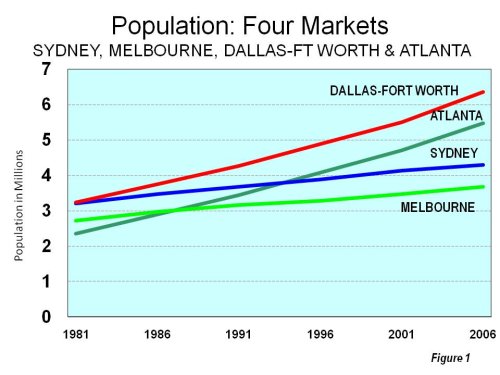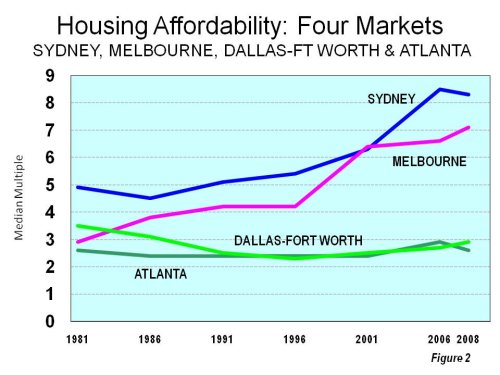Australia’s strong financial sector
Australia remains the lucky country, having largely avoided the Great Recession. It helped that the financial sector was overseen by adults, There was little of the “drunken sailor” mortgage lending policies to borrowers who couldn’t hope to repay that sunk the US and world economy. It is not surprising that the World Economic Forum’s International Competitiveness Report (PDF 3.7MB) ranks Australia’s banks as 3rd most sound out of 133 nations, outdistancing Bangladesh (#101), Mali (#105), the United States (#108) and the United Kingdom (#120).
Australia’s housing affordability crisis
However, Australia has a serious housing affordability problem. Each year, we produce the Demographia International Housing Affordability Survey (PDF 721KB), which rates housing affordability in more than 200 metropolitan area markets in six nations (Australia, Canada, Ireland, New Zealand, the United Kingdom and the United States), using the median multiple (median house price divided by median household income). Australian markets are among the most unaffordable of the lot.
It was not always this way. In 2006, former Reserve Board of Australia (RBA) Governor Ian MacFarlane told a parliamentary committee how his parents had purchased a block of land “very cheaply” in Melbourne in the 1950s and put a house on it “very cheaply”. Throughout Australia, housing was inexpensive into the 1970s, when housing affordability declined severely in Sydney. Prices were to escalate relative to incomes in the other major capital cities in the 1980s and 1990s with a doubling or more of prices relative to incomes.
Advertisement
Yet, new houses can still be built cheaply. But the cheap housing block is no more. Housing Industry of Australia data shows that the construction costs of a standardised house rose only 4 per cent relative to inflation between 1973 and 2006 in the major capital cities. The price of the block has risen nearly 400 per cent, inflation adjusted. This means that 98 per cent of the increased cost is in the land, not construction.
The principal cause of these extraordinary cost increases is the severe housing regulation pervading Australia. Urban consolidation policies stingily limit building on developable land around the cities, forcing most new construction into the existing urban footprint. Landowners within buildable areas know this and, being human beings, seek the highest price possible in the rigged sellers market established by government. If development were allowed on the urban fringe, competition between land owners would make houses more affordable.
Repealing the Great Australian Dream
Before urban consolidation, houses were built on quarter acre blocks on or beyond urban fringes. The Great Australian Dream was also built, along with cities among the most livable in the world and an affluent middle class with few international peers. If urban consolidation had been in place in the decades following World War II, the “Great Australian Dream” would have largely not emerged.
Apologists for the housing unaffordability make comparisons to nations similarly regulated, where prices have been driven sky high. They point to Australia’s high growth rate and claim that this higher demand drives prices up. However, demand does not increase prices unless supply is constrained. And, land supply has been constrained with a vengeance. It is virtually illegal to develop cheap land on the urban fringe.
A tale of four cities
The devastating impact on housing affordability can be shown by comparing metropolitan areas that regulate land similar to the abandoned model that produced the Great Australian Dream. The American metropolitan areas of Dallas-Fort Worth and Atlanta are compared to Sydney and Melbourne.
In 1981, Sydney and Dallas-Fort Worth were approximately the same population. Dallas-Fort Worth has grown much faster and is now nearly 50 per cent larger than Sydney. In 1981, Melbourne was larger than Atlanta. Atlanta has also grown faster and is approximately 50 per cent larger than Melbourne and more than a quarter larger than Sydney (see Figure 1 below).
Advertisement

Obviously, the demand for housing was greater in the much faster growing markets of Dallas-Fort Worth and Atlanta than in Sydney and Melbourne. Yet house prices did not rise relative to incomes, because the planning systems permitted development on cheap land. In 1981, the median multiple in Dallas-Fort Worth was 3.5. By 2008, it had dropped to 2.7. Atlanta had a median multiple of 2.6 in 1981 and it remained 2.6 in 2008. Moreover, these and other liberally regulated metropolitan areas missed the housing bubble.
By comparison, housing affordability deteriorated in Melbourne, from a median multiple of 2.9 in 1981to 7.1 in 2008. Sydney, with its earlier excessive regulation, had a median multiple of 4.9 in 1981, but worsened to 8.3 by 2008 (Figure 2).

Indeed, Dallas-Fort Worth and Atlanta have grown more than all Australia’s capital cities combined since 1981 (population and urban footprint). Yet, sufficient new infrastructure was provided and taxes remained low by national standards. City planning orthodoxy in Australia says this is impossible. Finally, even with more people and land area, Dallas-Fort Worth and Atlanta have average work trip travel times less than Sydney.
Depth of the problem
Australia may have missed the Great Recession, but its housing affordability remains abysmal. A recent Bank West report (PDF 1.71MB) found that only 5 to 20 per cent of key workers could afford the median priced house in capital cities (nurses, teachers, police officers, fire fighters and ambulance workers). The irony is not lost on RBA Governor Glenn Stevens who wisely observed in a recent Melbourne conference that, “It's a question of how is it, in a country this big in area and this small in numbers of people, we can't manage to make the marginal price of a dwelling lower than it is”.
Clearly something needs to be done. Luck is running out for the next generation of Australians. They will have to pay much more of their income for housing than their parents. This will mean that they will have less to spend on consumer goods and, as a result, fewer jobs will be created. As a result, the next generation is not likely to live as well as their parents.